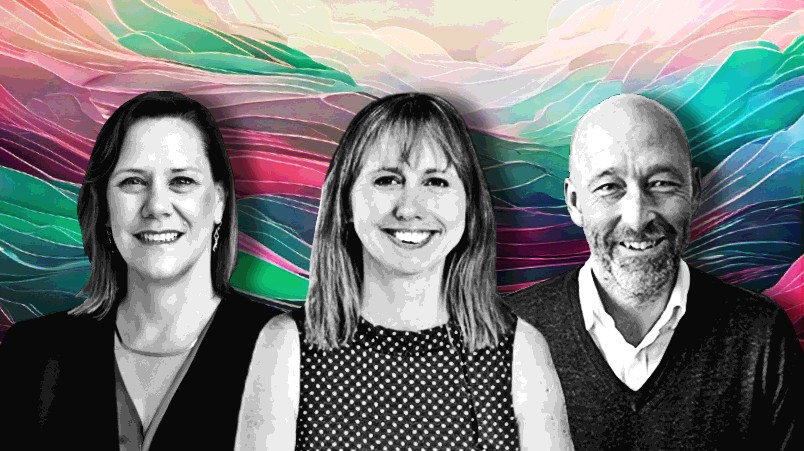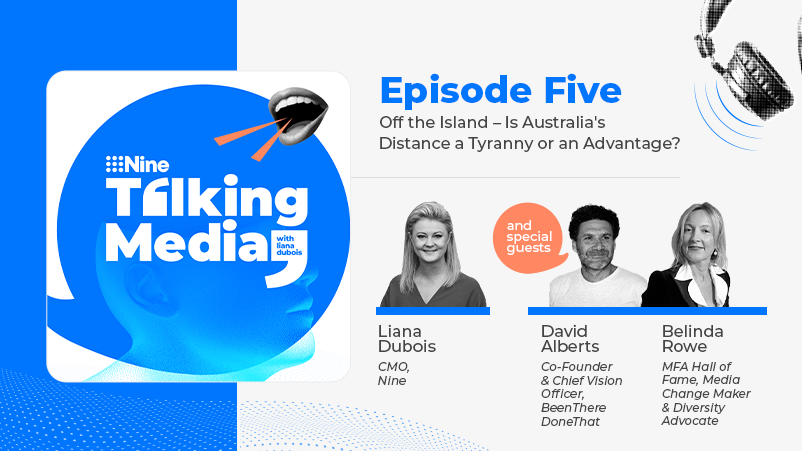IAB, Ipsos and OzTam merge BVOD, CTV data into digital currency touting sharper read on consumer behaviour shifts, loyalty app moves; back Australia to crack cross-media measurement as UK's Origin falters

Currency corral: OzTam CEO Karen Halligan, IAB Australia CEO Gai Le Roy and Ipsos ANZ CEO, Simon Wake.
Two and a half years after ditching Nielsen for Ipsos, the IAB is in market with the next phase of its plan to build a true cross-media currency. BVOD data via OzTam is now live, more connected TV data is incoming from both streamers and social media platforms – and the CEOs of all three organisations think "rat bag" Australia can ultimately succeed where markets such as the UK have seemingly succumbed to political stalemate. For now, the new data brings a sharper read not just on reach across the piste but on shifts in consumer behaviour – like how people are hopping from loyalty apps and into media and back again. Which means less guesswork for advertisers.
What you need to know:
- Next phase of digital currency now live, BVOD and CTV data integrated into Ipsos’ Iris measurement system.
- It means advertisers can combine and compare BVOD audiences across devices, including CTV, alongside broader web and app audiences.
- That's highly valuable for publishers too. "If I'm a Nine, I now have all my BVOD and all my mastheads as an unduplicated audience number from a third party data source," per IAB CEO Gai Le Roy.
- Plus planners get a sharper read on audience behaviours across channels: Le Roy said the system provides insights into how people are moving from loyalty apps and into BVOD and web environments and back again.
- Streamers and social media platforms to be integrated next, per Ipsos ANZ CEO Simon Wake, who said retail media players now also lining up.
- Per OzTam CEO Karen Halligan, advertisers urging full spectrum cross-platform currency, but warned rushing data alignment and integration would be “reckless”.
- But all three CEOs think it can be done – and Australia may yet deliver where larger markets such as the UK have seemingly come unstuck, if political wrangling can be overcome.
- Yet time waits for no currency. Three years on from the IAB deciding to go to market, and almost five years since the WFA pushed for Origin, panel providers have developed workarounds. Amazon, Google, Unilever and Virgin are using them globally, plus Kmart locally.
It’s a very robust, accurate reflection of what’s actually going on in consumer behaviour that I don’t think we’ve really seen before.
Guess less
Billed as a world first, the integration of BVOD data into the Iris system means the market can properly measure video audiences across the piste, getting a handle on combined reach and overlap across devices while stacking them up against digital audiences more broadly, i.e. web and apps via Ipsos' single source panel.
Broadcasters, said Le Roy, now have “more accurate data from the three devices that are already in Ipsos – smartphones, tablets and PCs – and we're also adding in CTV audience and volume information for the first time”.
OzTam CEO Karen Halligan said with the currency now ingesting OzTam data “from 16 million devices measured daily, it’s a very robust, accurate reflection of what’s actually going on in consumer behaviour that I don’t think we’ve really seen before”.
It short, it means marketers get a better read of video audiences across devices to better understand reach, frequency and duplication while buyers and broadcasters have a clearer picture of audience behaviour across the piste. “So if I'm a Nine, I now have all my BVOD and all my mastheads as an unduplicated audience number from a third party data source,” per Le Roy. Agencies, “particularly those large holding groups” now have “robust currency data across those two ecosystems without having to guess.”
Project Origin was – is – amazing. [But] it came up with almost a framework of utopia. Maybe we’re rat bag Australians, but we're building from the bottom up a little more, and it feels like we're able to get a bit more progress.
Single origin?
Ipsos ANZ CEO Simon Wake said the rollout “is moving towards real cross-media measurement services” which OzTam's Halligan indicated is a key ask from advertiser bodies such as the AANA.
Neither Wake, Le Roy nor Halligan would be drawn on a timetable, but Le Roy thinks Australia may be able to overcome some of the challenges that have seemingly bogged down the UK’s Project Origin. That project was initiated by the World Federation of Advertisers in 2019 and subsequently taken forward by ISBA – the UK's peak advertiser association – with the two bodies plus major advertisers such as Unilever bidding to corral disparate audience currencies across legacy media and digital. But it's been quiet of late. Australia under then-AANA CEO John Broome was set to be a "fast follower". Can it instead pick up the baton?
“I think that the demand and the requests [from advertisers] will push us further and further towards that path,” said Halligan. But she warned against “reckless” rushing given the ad dollars at stake.
“We need to make sure if we're merging data sets that we're using rich, deep, accurate information that puts the true picture of consumption forward, not mixed currencies with different sources, different structures to data and information … that doesn't accurately represent what's going on,” said Halligan. “There will always be a cautiousness around how that actually comes to life.”
IAB’s Le Roy thinks it can be done – though not via a big bang approach. More a series of smaller bangs.
“Origin was – is – amazing. [But] it came up with almost a framework of utopia. Maybe we’re rat bag Australians, but we're building from the bottom up a little more, and it feels like we're able to get a bit more progress,” she said.
“For us going out to tender [in 2021] the appetite was to have screens measured as accurately as possible. That’s where most of the money is. So [the plan is to move] one step at a time rather than trying to necessarily go, here's the ideal and how do we create that – it feels like that's where a lot of the problems come,” said Le Roy. But she said the currency will “move more and more towards” true cross-media measurement and thinks Australia may succeed where others have seemingly come unstuck.
“In the local market, we all know each other talk to each other. There's always politics but we also have a closer, more collaborative market which helps us move forward a little quicker.”
Wake said Ipsos, while involved in early Project Origin trials, it had no input since Kantar was awarded the tender in 2021. “I think it’s technically possible. I think the biggest barrier has been political.” Ipsos has built a cross media measurement platform – albeit for a single broadcaster, the BBC – that spans TV, radio and digital. “So it's technically possible,” said Wake. “It's just how you get there [with multiple parties and interests].”
We've got lots of retail media clients coming on board now wanting to understand the use of their properties, but also that broader digital behaviour set.
Loyalty read
In the meantime, the next phase brings marketers some new audience behaviour intelligence, which Le Roy said underlines how consumer spending pressure is playing out.
“The thing to remember about the Ipsos Iris dataset is it's not just media. It's all that consumer behaviour across digital devices,” she said.
That provides the ability to see, for example, “that the people who went into the NAB app also went into Nine Now … The people going into Qantas Loyalty or Flybuys, how they're then interacting with news properties, or video”. Ipsos' Wake said the same applied to things like gambling apps.
Across the piste, people seeking out better deals and hunting value via loyalty programs “is really coming through from a currency point of view”, per Le Roi. Advertisers and media agencies, she said, “need to be able to plan on that very current and credible data.”
She thinks that need will sharpen as 2024 plays out.
“We know we’re going to be losing signals with Chrome [cookie deprecation] and privacy regulation. So the fact that we've got a data set that can look at cross-site behaviour is going to become increasingly important, because it's going to be hard to patch all that together.”
Ipsos’ Wake said the firm “has not yet mined all the data” its sitting on, circa “90 per cent of devices across Australia” through its hybrid panel data, “because we've been so busy just getting the kind of media metrics out there.”
He said there is more data incoming.
“We've got lots of retail media clients coming on board now wanting to understand the use of their properties, but also that broader digital behaviour set,” said Wake. “We’ve now got the OzTam data and there are a couple more to come on.” Streamers and social platforms are next.
We could see the difference of people who, within a two-week span, had seen the ad and then gone into a Kmart store versus people who hadn't seen the ad. We could directly measure that uplift in real time, specifically broken down for each channel.
Panel betas?
Yet while Ipsos has the official currency nod, other single source panel providers have already hacked workarounds in their pursuit of cross-media audience analysis and measurement in the years it has taken BVOD plus web and apps to materialise. Kmart and IPG's UM and Kinesso, for instance, have deployed Beatgrid's tech, used by Amazon, Google, Unilever and Virgin, in a trial across linear TV, BVOD, YouTube and in-store footfall.
Beatgrid’s system applies "inaudible pitch shifts" to creative across different screen types, per Kinesso's Digital Strategy Director, Charlie Allatt, using those shifts to “unwind whether people are being exposed in a particular channel.”
Using Beatgrid's location data (via a paid mobile phone panel) it mapped the ads served to audiences against Kmart's in-store traffic. "We could see the difference of people who, within a two-week span, had seen the ad and then gone into a Kmart store versus people who hadn't seen the ad," per Allatt. "We could directly measure that uplift in real time, specifically broken down for each channel."
Kmart's GM of Marketing, Rennie Freer, said the retailer had to demonstrate "we are reaching customers really efficiently ensuring every dollar we invest is performing". She said the Beatgrid pilot "was a great opportunity because if we're saving dollars here, if what we're doing is really delivering the efficacy we need, we can reinvest in new channels."
Interestingly, UM and Kinesso ran the numbers against OzTam's data for linear and BVOD and DV360 for YouTube and both "tilted very, very closely to Beatgrid's numbers", according to UM's Group director for Kmart, Adam Russell.
The currency wars – official and breakaways – are heating up.



